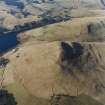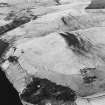Pricing Change
New pricing for orders of material from this site will come into place shortly. Charges for supply of digital images, digitisation on demand, prints and licensing will be altered.
Tormaukin
Farmstead (Period Unassigned), Field Boundary(S) (Period Unassigned), Head Dyke (Post Medieval), Rig And Furrow (Medieval) - (Post Medieval)
Site Name Tormaukin
Classification Farmstead (Period Unassigned), Field Boundary(S) (Period Unassigned), Head Dyke (Post Medieval), Rig And Furrow (Medieval) - (Post Medieval)
Canmore ID 112064
Site Number NN90SE 26
NGR NN 9954 0403
Datum OSGB36 - NGR
Permalink http://canmore.org.uk/site/112064
- Council Perth And Kinross
- Parish Glendevon
- Former Region Tayside
- Former District Perth And Kinross
- Former County Perthshire
NN90SE 26 9954 0403
A farmstead, which comprises two roofless buildings set against, and immediately above, a head-dyke, is depicted on the 1st edition of the OS 6-inch map (Perthshire 1866, sheet cxxvii). The current edition of the OS 1:10000 map (1980) depicts one roofless and one roofed building at this location.
Information from RCAHMS (PM) 16 August 1996.
There is a complex palimpsest of field-banks and cultivation on the southern flanks of Tormaukin. The field-banks form enclosures ranging from some relatively small examples, which may have been for stock, to larger fields taking in several hectares; amongst all these there is frequent evidence for sequences of construction. There are patches of rig scattered across the hillside and an extensive area of improved ground on the SW flank of the hill.
Information from RCAHMS (DCC) 2 December 2003
Project (1 May 2016 - 12 May 2017)
Archaeological features were identified and mapped from airborne remote sensing sources, such as lidar, historic vertical aerial photographs, and 25cm orthophotographs.
Information from HES (OA) 12 May 2017












































